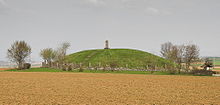Náčelnický hrob z Hochdorfu

Náčelnický hrob z Hochdorfu je bohatě vybavený keltský komorový hrob datovaný kolem roku 530 př. Kr. do halštatské periody D. Byl objeven amatérským archeologem v roce 1977 poblíž Hochdorfu an den Enz (okres Eberdingen) ve spolkové zemi Bádensko-Württembersko v Německu. Původně hrob překrývala asi 6 metrů vysoká mohyla mající v průměru 60 metrů, která ale v souvislosti s erozí a zemědělským využíváním klesla na stěží rozezatelný 1 metr.
Pohřbeným byl muž, vysoký 187 cm ve věku asi 40 let, který byl uložen na výjimečně bohatém, 275 cm dlouhém bronzovém lehátku, opatřeném kolečky. Soudě podle ostatních nálezů z hrobu byl muž pravděpodobně keltským náčelníkem. Byl pohřben společně s pozlaceným nákrčníkem, náramkem na pravé paži, čepicí z březové kůry, pozlacenou dýkou vyrobenou z bronzu a železa, bohatým ošacením, jantarovými šperky, břitvou na holení, výbavou pro manikúru, hřebenem, rybářskými háčky, šípy a především s tenkými zlatými plaketami, pokrývajícími jeho (nedochované) boty. V blízkosti lehátka byl nalezen velký kotel zdobený na okraji třemi lvy. Ten původně obsahoval přibližně 400 l medoviny. Východní část hrobu obsahovala železem pobitý čtyřkolový vůz ukrývající set bronzových misek – společně s picími rohy nalezenými na stěnách by se dal použít k servírování až pro 9 osob.
Po prozkoumání hrobu byla mohyla rekonstruována do svých původních rozměrů. Nedaleko bylo postaveno muzeum věnované tomuto výjimečnému nálezu a při jeho stavbě byly odhaleny relikty pravěké keltské vesnice, která byla pravděpodobně jednou z těch, které pohřbený během svého života ovládal. Vesnice byla přidána do téhož muzea.
Galerie
- Rekonstrukce hrobové komory v nedalekém muzeu
- Pozlacená dýka
- Roh na pití
- Zlaté plakety původně umístěné na obuvi
Reference
V tomto článku byl použit překlad textu z článku Hochdorf Chieftain's Grave na anglické Wikipedii.
Externí odkazy
 Obrázky, zvuky či videa k tématu Náčelnický hrob z Hochdorfu na Wikimedia Commons
Obrázky, zvuky či videa k tématu Náčelnický hrob z Hochdorfu na Wikimedia Commons
Média použitá na této stránce
Autor: Rosemania, Licence: CC BY 2.0
Hochdorf Chieftain's Grave, Germany.
About 530 BC
The Hochdorf Chieftain's Grave is a richly-furnished burial chamber. Regarded as the "Tutankamon of the Celts", it was discovered in 1977 near Hochdorf an der Enz in Baden-Württemberg, Germany). A man of 40 years old, 6 ft 2 in (188 cm) tall was laid out on a bronze couch. He had been buried with a gold-plated torc on his neck, a bracelet on his right arm, and most notably, thin embossed gold plaques were on his now-disintigrated shoes. At the foot of the couch was a large cauldron decorated with three lions around the brim. The east side of the tomb contained a four-wheeled wagon holding a set of bronze dishes - enough to serve nine people.
Kunst der Kelten, Historisches Museum Bern.
Art of the Celts, Historic Museum of Bern.Autor: Rosemania, Licence: CC BY 2.0
Hochdorf Chieftain's Grave, Germany.
About 530 BC
Gilded in preparation for the afterlife, this 42cm long, bronze and iron dagger was carried by the prince in life. The blade was protected by a richly decorated sheath. The gold coating made for the burial consisted of 16 parts, all precisely fitted onto the dagger without any fold.
The Hochdorf Chieftain's Grave is a richly-furnished burial chamber. Regarded as the "Tutankamon of the Celts", it was discovered in 1977 near Hochdorf an der Enz in Baden-Württemberg, Germany). A man of 40 years old, 6 ft 2 in (187 cm) tall was laid out on a bronze couch. He had been buried with a gold-plated torc on his neck, a bracelet on his right arm, and most notably, thin embossed gold plaques were on his now-disintigrated shoes. At the foot of the couch was a large cauldron decorated with three lions around the brim. The east side of the tomb contained a four-wheeled wagon holding a set of bronze dishes - enough to serve nine people.
Kunst der Kelten, Historisches Museum Bern.
Art of the Celts, Historic Museum of Bern.Autor: Chez Cåsver (Xuan Che), Licence: CC BY 2.0
Hochdorf Chieftain's Grave, Germany.
- Camera: Panasonic DMC-LX2
- License on Flickr (2011-03-05): CC-BY-2.0
- Flickr tags: summer, 2009, july, europe, bern, switzerland, museum, ancient
About 530 BC The Hochdorf Chieftain's Grave is a richly-furnished burial chamber. Regarded as the "Tutankamon of the Celts", it was discovered in 1977 near Hochdorf an der Enz in Baden-Württemberg, Germany). A man of 40 years old, 6 ft 2 in (178 cm) tall was laid out on a bronze couch. He had been buried with a gold-plated torc on his neck, a bracelet on his right arm, and most notably, thin embossed gold plaques were on his now-disintigrated shoes. At the foot of the couch was a large cauldron decorated with three lions around the brim. The east side of the tomb contained a four-wheeled wagon holding a set of bronze dishes - enough to serve nine people. This horn has a capacity of 5.5 litres, which was enough to get suitably inebriated. It's the largest and most precious drinking horn, specially reserved for the host. The iron was forged into the shape of a horn and decorated with shear gold. The tip was adorned with beads made of bones. Kunst der Kelten, Historisches Museum Bern.
Art of the Celts, Historic Museum of Bern.Autor: Detlef Meissner, Licence: CC BY 2.5
Celtic burial mound Hochdorf / Enz
Autor: jnn95, Licence: CC BY-SA 3.0
Reconstruction of the Celtic Hochdorf Chieftain's Grave in the museum nearby the location of the original grave








